Abstract: The most common fault in high-voltage transmission lines is single-phase ground faults. In order to improve the sensitivity of the distance relay to single-phase ground fault and simplify the expression of the relay, the unified form of the single-phase compensation ground distance relay is proposed by analyzing the polarization of the ground distance relay. By changing the parameters, more than 10 commonly used single-phase ground distance relays can be constructed.
0 Introduction Single-phase ground faults often account for over 80% of all types of faults in high voltage transmission lines. Therefore, improving the performance of single-phase grounding relays is of great significance for reducing the losses caused by faults and improving the stability of the system. For a long time, the majority of relay protection workers have proposed a variety of grounding distance relays in the practice of scientific research and production. These relays have different ways of expression and have slightly different performance characteristics [1]. Analyzing and studying the performance of these relays, and then improving and improving them, has become an important part of relay protection research. For the sake of research convenience, the literature [2] divides these relays into 3 categories: single-phase impedance relays; multi-phase impedance relays, ranging distance relays. The literature [3] divides them into four categories according to the amount of movement and polarization of relays. Various classification methods have different focuses.
This article will be divided into two types of grounding distance relays: 1 single-phase compensation type grounding distance relay, that is, only the use of the fault phase information or to compensate for the ground distance relay, this article referred to as the first category; 2 multi-phase compensation grounding distance Relays, which are ground-based distance relays that use comprehensive information on the health and fault phases, are referred to as Category II. Those belonging to the first category include: single-phase impedance relays, fault-component impedance relays, and fault-component reactance relays. Class II are: multi-phase compensation distance relays, sequence component distance relays, ranging distance relays. The quadrilateral distance relay and the integrated ratio phase relay are actually the combined use of several types of relays in the first and second categories.
Through the research, it is found that the grounding distance relays of the first type have many common features in terms of performance, and the difficulties are very similar. They can be expressed in a unified form and comprehensively studied.
The significance of this unified form is:
a. Can meet the different practical needs of the scene. In the actual application process on site, it is often necessary to select different ground distance relays for different system conditions. This is reflected in the need to program different relay subroutines in the microcomputer protection, and to install different relays in analog protection. With the unified representation form, it is possible to implement various relays simply by selecting different setting values, thereby greatly enhancing the flexibility of field applications while simplifying the program design.
b. Created conditions for further technological innovation. This is especially important. By revealing the essential characteristics of the single-phase compensated ground-distance relay in a unified expression, a new ground-distance relay can be created according to the actual situation.
1 The unified form of the single-phase compensation type grounding distance relay The single-phase compensation type grounding distance relay designed in this paper can have the following two forms: (1) and (2):
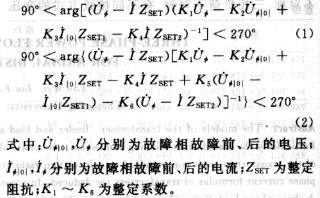
As can be seen from the comparison equations (1) and (2), formula (1) can be obtained by simplifying the equation (2). This paper gives formula (2) mainly to better understand the meaning of the unified form.
2 The relationship between the unified form and the ground distance relay The following describes how the unified form can be converted to the existing various forms of single-phase compensated ground distance relays by giving a setting coefficient.
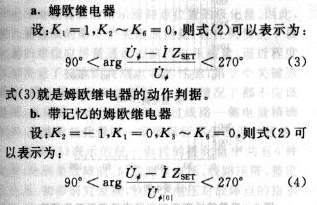
Equation (4) is the operating criterion of the Mohm relay with memory.
c. Fault component impedance relay The action criterion of the fault component impedance relay shown in [1] is:
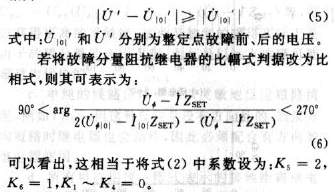
d. Reactance relay Reactance relay usually used in the form of representation:
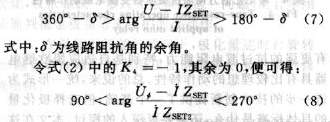
Moving the phase angle of ZSET2 to both sides of equation (8) shows that Equation (7) and Equation (8) are actually identical.
e. Drop ball characteristic impedance relay
When different ZSET2 is set, various impedance relays with offset characteristics or ball drop characteristics can be obtained.
To summarize the above situation, the relationship between various single-phase compensation grounding distance relays and the various forms of unified settings can be obtained, as shown in Table 1. The table also lists several other relay types and their tuning values.
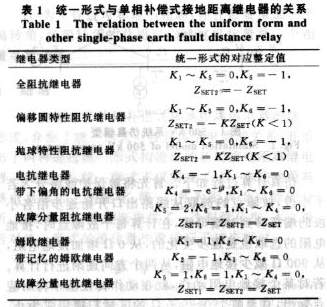
If the amount of polarization of each relay is shifted as needed, this can be achieved by changing the phase angle of K1 to K6.
3 Two new grounding distance relays The following describes two new grounding distance relays constructed in accordance with the unified form.
a. Adaptive Mio relay

The unique advantage of this relay is that its operation boundary can change dynamically with the grounding resistance, so that it has a good ability to withstand grounding resistance. The form of the action criterion is very simple, easy to understand and easy to set.
b. Sensitive ground distance relay
The unique advantages of this relay are: its operation boundary is fixed and affected by the transition resistance is very small, it has a good resistance to ground resistance; its action boundary is actually established in accordance with the end of the protection zone, so the form of action criteria is very intuitive, Easy to understand. However, when faults outside the area and faults in the reverse direction, malfunctions may occur, and auxiliary criteria need to be added to ensure their reliability.
In order to perform the analysis and comparison intuitively, the simulation results of the TRCP-2 impedance relay transient characteristic analysis program based on the ATP complex network model are given below. The system simulation model is shown in Figure 1.
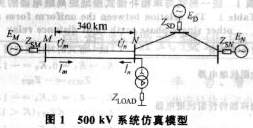
The simulation calculation process is as follows. First, the protected circuit is divided into several small segments. The selection of the fault point is gradually moved from the exit of the line to the opposite bus along the ends of each segment. When calculating each fault point, the selection of the grounding resistance also gradually changes from 0 Ω. Increase the grounding resistance, reduce the grounding resistance from 900Ω, and gradually calculate from both directions. If a certain grounding resistor is operated, the corresponding point is marked in the operating characteristic diagram until the entire 0-900Ω region scan is completed. FIGS. 2 to 4 respectively show the operating characteristics of the adaptive Mio relay, the sensitive distance relay and the directional impedance relay under the same system parameters. In the figure, the dashed line area indicates the protection operation area, and the blank area indicates the protection non-operation area. Each figure respectively shows the protection installed at the power transmission side and the power receiving side. The failure type is A phase ground fault, relay Phases are phase A, L is the percentage of electrical distance.
It can be seen from the simulation graphs in Figure 2 to Figure 4 that the two types of single-phase distance relays proposed in this paper are relative to the directional impedance relays.


There is more resistance to transition resistance, especially the adaptive mOu relay has more ideal operating characteristics. In general, the unified form provides a basis for further technological innovation. However, the specific criteria for selecting the amount of polarization need to be further explored. This article makes a preliminary consideration in this regard.
4 The theoretical study of the unified form of polarization quantity selection From the unified form, it can be seen that the operation amount of various single-phase grounding distance relays is exactly the same, and the only difference is the polarization quantity. It is the difference in polarization that directly affects the performance of the ground-distance relay. This is because the amount of movement only serves to indicate the setpoint voltage, that is, the location of the protected area, and the amount of polarization serves to indicate whether the short-circuit point is within the protected area. Therefore, it is particularly important to discuss the method of selecting the polarization quantity, which is directly related to the accuracy of the indication of this short circuit point, especially when the short circuit is near the end of the protection zone. The following is a theoretical discussion of the selection method for the polarization of Class 1 grounding distance relays for commercial discussion.
Here, we first make it clear that in any case, the voltage at the short-circuit point is the most effective one that indicates the position of the short-circuit point. Therefore, the first key principle for selecting the polarization amount is: In any case, the phase of the polarization should be as close to the short-circuit point voltage phasor as possible, and the degree of approximation directly determines the performance of the ground distance relay. The second key principle is: Because the ground distance relay should not be exceeded in any case, and the short-circuit point voltage can not be accurately obtained through the side of the line power, when selecting the polarization amount must ensure that no protection is exceeded.
The total amount of polarization in the unified form represented by equation (2) is six types of power, namely the measured voltage before and after the fault, the line voltage drop, and the set point voltage. A preliminary study found that the six voltages played different roles in the indication of faults and are summarized as follows:
a. The short-term sensitivity of the fixed point voltage response near the end of the protection range is good, but the sensitivity at the end of the protection zone is relatively poor.
b. While using the same amount of voltage before and after the short circuit, for example:

For greater sensitivity. The gain of this sensitivity is actually caused by the selection of the fault component, and it is at the cost of a remote fault that may be exceeded.
c. A simple line voltage drop can also react sensitively to a short circuit condition, such as ìZSET. However, this response is non-directional. When the reverse direction is short-circuited, the relay will act, so it must be used with a directional relay.
d. All ground-distance relays that can be represented in a uniform form face the influence of the "in-phase problem," because the phase relationship between the ideal polarization quantity UF and the amount of movement before and after the in-phase point has undergone a qualitative change, and this cannot be resolved by relying only on the unified form. One problem, and the use of switching criteria can easily bring about the protection of the malfunction.
e. In the case that the guarantee does not exceed, the point voltage after the polarization amount is rotated counterclockwise by 90° is closer to the point voltage after the fault to make the relay withstand a higher grounding resistance.
f. In order to ensure reliable non-overshoot, it is often necessary to increase a deflection angle, which can be obtained by multiplying the polarization amount by a phasor coefficient.
5 Conclusion In this paper, the unified form of the single-phase compensation type grounding distance relay is proposed, and the relationship between the unified form and each specific relay is introduced, and two new grounding distance relays constructed in a unified form are given. It can be found that the unified form not only realizes the simplification and unification of this type of ground distance relay, but also provides a scientific basis for the analysis, selection and further innovation of distance relays. At the end of this paper, the preliminary study of the selection of polarization in the unified form is carried out.
0 Introduction Single-phase ground faults often account for over 80% of all types of faults in high voltage transmission lines. Therefore, improving the performance of single-phase grounding relays is of great significance for reducing the losses caused by faults and improving the stability of the system. For a long time, the majority of relay protection workers have proposed a variety of grounding distance relays in the practice of scientific research and production. These relays have different ways of expression and have slightly different performance characteristics [1]. Analyzing and studying the performance of these relays, and then improving and improving them, has become an important part of relay protection research. For the sake of research convenience, the literature [2] divides these relays into 3 categories: single-phase impedance relays; multi-phase impedance relays, ranging distance relays. The literature [3] divides them into four categories according to the amount of movement and polarization of relays. Various classification methods have different focuses.
This article will be divided into two types of grounding distance relays: 1 single-phase compensation type grounding distance relay, that is, only the use of the fault phase information or to compensate for the ground distance relay, this article referred to as the first category; 2 multi-phase compensation grounding distance Relays, which are ground-based distance relays that use comprehensive information on the health and fault phases, are referred to as Category II. Those belonging to the first category include: single-phase impedance relays, fault-component impedance relays, and fault-component reactance relays. Class II are: multi-phase compensation distance relays, sequence component distance relays, ranging distance relays. The quadrilateral distance relay and the integrated ratio phase relay are actually the combined use of several types of relays in the first and second categories.
Through the research, it is found that the grounding distance relays of the first type have many common features in terms of performance, and the difficulties are very similar. They can be expressed in a unified form and comprehensively studied.
The significance of this unified form is:
a. Can meet the different practical needs of the scene. In the actual application process on site, it is often necessary to select different ground distance relays for different system conditions. This is reflected in the need to program different relay subroutines in the microcomputer protection, and to install different relays in analog protection. With the unified representation form, it is possible to implement various relays simply by selecting different setting values, thereby greatly enhancing the flexibility of field applications while simplifying the program design.
b. Created conditions for further technological innovation. This is especially important. By revealing the essential characteristics of the single-phase compensated ground-distance relay in a unified expression, a new ground-distance relay can be created according to the actual situation.
1 The unified form of the single-phase compensation type grounding distance relay The single-phase compensation type grounding distance relay designed in this paper can have the following two forms: (1) and (2):

As can be seen from the comparison equations (1) and (2), formula (1) can be obtained by simplifying the equation (2). This paper gives formula (2) mainly to better understand the meaning of the unified form.
2 The relationship between the unified form and the ground distance relay The following describes how the unified form can be converted to the existing various forms of single-phase compensated ground distance relays by giving a setting coefficient.

Equation (4) is the operating criterion of the Mohm relay with memory.
c. Fault component impedance relay The action criterion of the fault component impedance relay shown in [1] is:

d. Reactance relay Reactance relay usually used in the form of representation:

Moving the phase angle of ZSET2 to both sides of equation (8) shows that Equation (7) and Equation (8) are actually identical.
e. Drop ball characteristic impedance relay

When different ZSET2 is set, various impedance relays with offset characteristics or ball drop characteristics can be obtained.
To summarize the above situation, the relationship between various single-phase compensation grounding distance relays and the various forms of unified settings can be obtained, as shown in Table 1. The table also lists several other relay types and their tuning values.

If the amount of polarization of each relay is shifted as needed, this can be achieved by changing the phase angle of K1 to K6.
3 Two new grounding distance relays The following describes two new grounding distance relays constructed in accordance with the unified form.
a. Adaptive Mio relay

The unique advantage of this relay is that its operation boundary can change dynamically with the grounding resistance, so that it has a good ability to withstand grounding resistance. The form of the action criterion is very simple, easy to understand and easy to set.
b. Sensitive ground distance relay

The unique advantages of this relay are: its operation boundary is fixed and affected by the transition resistance is very small, it has a good resistance to ground resistance; its action boundary is actually established in accordance with the end of the protection zone, so the form of action criteria is very intuitive, Easy to understand. However, when faults outside the area and faults in the reverse direction, malfunctions may occur, and auxiliary criteria need to be added to ensure their reliability.
In order to perform the analysis and comparison intuitively, the simulation results of the TRCP-2 impedance relay transient characteristic analysis program based on the ATP complex network model are given below. The system simulation model is shown in Figure 1.

The simulation calculation process is as follows. First, the protected circuit is divided into several small segments. The selection of the fault point is gradually moved from the exit of the line to the opposite bus along the ends of each segment. When calculating each fault point, the selection of the grounding resistance also gradually changes from 0 Ω. Increase the grounding resistance, reduce the grounding resistance from 900Ω, and gradually calculate from both directions. If a certain grounding resistor is operated, the corresponding point is marked in the operating characteristic diagram until the entire 0-900Ω region scan is completed. FIGS. 2 to 4 respectively show the operating characteristics of the adaptive Mio relay, the sensitive distance relay and the directional impedance relay under the same system parameters. In the figure, the dashed line area indicates the protection operation area, and the blank area indicates the protection non-operation area. Each figure respectively shows the protection installed at the power transmission side and the power receiving side. The failure type is A phase ground fault, relay Phases are phase A, L is the percentage of electrical distance.
It can be seen from the simulation graphs in Figure 2 to Figure 4 that the two types of single-phase distance relays proposed in this paper are relative to the directional impedance relays.



There is more resistance to transition resistance, especially the adaptive mOu relay has more ideal operating characteristics. In general, the unified form provides a basis for further technological innovation. However, the specific criteria for selecting the amount of polarization need to be further explored. This article makes a preliminary consideration in this regard.
4 The theoretical study of the unified form of polarization quantity selection From the unified form, it can be seen that the operation amount of various single-phase grounding distance relays is exactly the same, and the only difference is the polarization quantity. It is the difference in polarization that directly affects the performance of the ground-distance relay. This is because the amount of movement only serves to indicate the setpoint voltage, that is, the location of the protected area, and the amount of polarization serves to indicate whether the short-circuit point is within the protected area. Therefore, it is particularly important to discuss the method of selecting the polarization quantity, which is directly related to the accuracy of the indication of this short circuit point, especially when the short circuit is near the end of the protection zone. The following is a theoretical discussion of the selection method for the polarization of Class 1 grounding distance relays for commercial discussion.
Here, we first make it clear that in any case, the voltage at the short-circuit point is the most effective one that indicates the position of the short-circuit point. Therefore, the first key principle for selecting the polarization amount is: In any case, the phase of the polarization should be as close to the short-circuit point voltage phasor as possible, and the degree of approximation directly determines the performance of the ground distance relay. The second key principle is: Because the ground distance relay should not be exceeded in any case, and the short-circuit point voltage can not be accurately obtained through the side of the line power, when selecting the polarization amount must ensure that no protection is exceeded.
The total amount of polarization in the unified form represented by equation (2) is six types of power, namely the measured voltage before and after the fault, the line voltage drop, and the set point voltage. A preliminary study found that the six voltages played different roles in the indication of faults and are summarized as follows:
a. The short-term sensitivity of the fixed point voltage response near the end of the protection range is good, but the sensitivity at the end of the protection zone is relatively poor.
b. While using the same amount of voltage before and after the short circuit, for example:
For greater sensitivity. The gain of this sensitivity is actually caused by the selection of the fault component, and it is at the cost of a remote fault that may be exceeded.
c. A simple line voltage drop can also react sensitively to a short circuit condition, such as ìZSET. However, this response is non-directional. When the reverse direction is short-circuited, the relay will act, so it must be used with a directional relay.
d. All ground-distance relays that can be represented in a uniform form face the influence of the "in-phase problem," because the phase relationship between the ideal polarization quantity UF and the amount of movement before and after the in-phase point has undergone a qualitative change, and this cannot be resolved by relying only on the unified form. One problem, and the use of switching criteria can easily bring about the protection of the malfunction.
e. In the case that the guarantee does not exceed, the point voltage after the polarization amount is rotated counterclockwise by 90° is closer to the point voltage after the fault to make the relay withstand a higher grounding resistance.
f. In order to ensure reliable non-overshoot, it is often necessary to increase a deflection angle, which can be obtained by multiplying the polarization amount by a phasor coefficient.
5 Conclusion In this paper, the unified form of the single-phase compensation type grounding distance relay is proposed, and the relationship between the unified form and each specific relay is introduced, and two new grounding distance relays constructed in a unified form are given. It can be found that the unified form not only realizes the simplification and unification of this type of ground distance relay, but also provides a scientific basis for the analysis, selection and further innovation of distance relays. At the end of this paper, the preliminary study of the selection of polarization in the unified form is carried out.
Jeep Wrangler Exterior Accessories
Jeep Tj Exterior Accessories,Jeep Wrangler Exterior Trim Kit,Jeep Wrangler Tj Exterior Accessories,Jeep Wrangler Exterior Parts
Danyang Weisheng Automotive Technology Co., Ltd , https://www.dywizsinparts.com
![<?echo $_SERVER['SERVER_NAME'];?>](/template/twentyseventeen/skin/images/header.jpg)